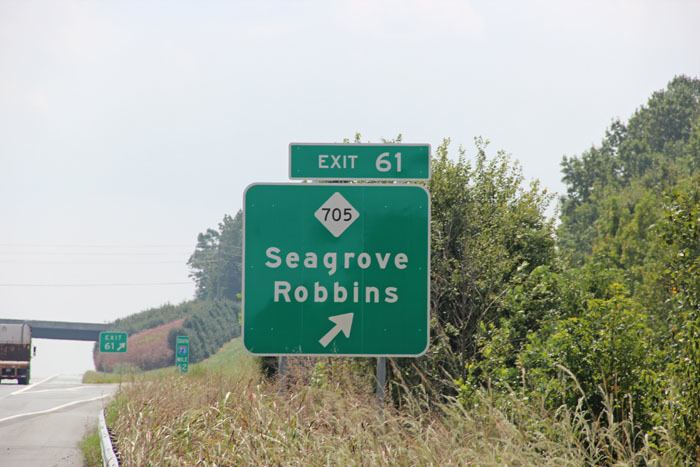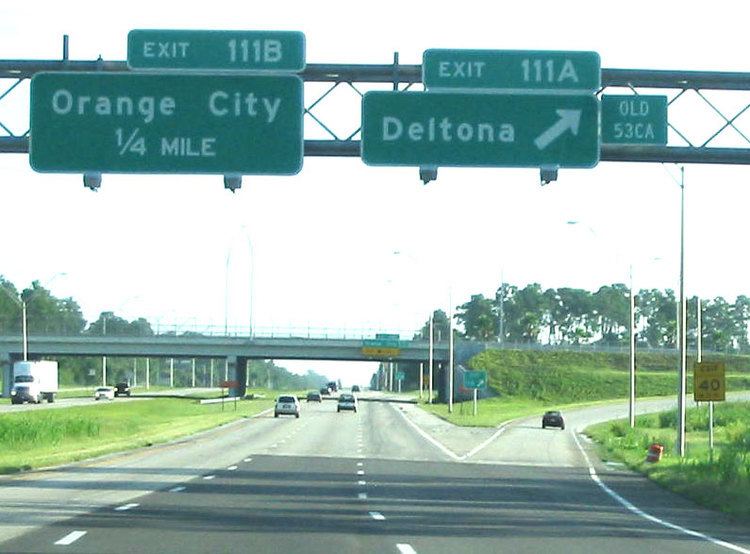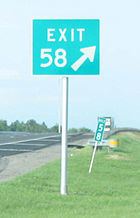 | ||
Ri highway exit numbers to change
An exit number is a number assigned to a road junction, usually an exit from a freeway. It is usually marked on the same sign as the destinations of the exit, as well as a sign in the gore.
Contents
- Ri highway exit numbers to change
- Glen burtnik exit number 9 on anything anything
- Sequential numbers
- Distance based numbers
- Australia
- British Isles and Continental Europe
- Canada
- Hong Kong
- Japan
- New Zealand
- Philippines
- South Africa
- Taiwan
- References

Exit numbers typically reset at political borders such as state lines. In some areas, such as New Jersey (and its New Jersey Turnpike), the numbers are a part of popular culture; a clichéd greeting is "what exit?".

Some non-freeways use exit numbers. Typically these are rural roads built to expressway standards, and either only the actual exits are numbered, or the at-grade intersections are also numbered. An extreme case of this is in New York City, where the Grand Concourse and Linden Boulevard were given sequential numbers, one per intersection (both boulevards no longer have exit numbers as of 2011). A milder version of this has been recently used on the West Side Highway, also in New York, where only the major intersections are numbered (possibly to match the planned exits on the cancelled Westway freeway). Another case is the Nanaimo Parkway in Nanaimo, British Columbia carrying Highway 19, where all exits are numbered though all except one are at-grade intersections. Some other intersections on Highway 19 outside Nanaimo are also given numbers.

As a means of educating motorists, some state highway maps include a brief explanation of the exit numbering system on an inset. Iowa DOT maps from the 1980s and 1990s included a picture or drawing of a milepost and briefly described how Iowa had included milepost references near interchanges on the map.

Glen burtnik exit number 9 on anything anything
Sequential numbers
The first exit numbers were sequential. This type of exit numbering usually begins with exit 1 at the beginning of the road; each subsequent exit is given the next number. The first implementations gave each ramp its own number, even when two ramps existed for two directions of a road; later implementations used directional suffixes, as in 15N/15S or 15E/15W; current U.S. and Canadian practice is to use 15A/15B. In France and Japan, decimals are used, as in 15.1 and 15.2.
Toll roads, especially those using tickets, lend themselves nicely to sequential numbering, as each toll plaza gets its own number. Problems arise when exits are added. For instance, an exit between 15 and 16 would typically be 15A. On the New York State Thruway, an exit was added between 21 and 21A, leading to the sequence 21 - 21B - 21A - 22. In Florida, some new exits got the suffix C, so that if it had or acquired separate exits for the two directions, they would be 15CA and 15CB rather than 15AB. There are also occurrences of this happening on the New Jersey Turnpike; the original interchanges opened in 1951, with newer exits as recently as 1982. On the Baltimore Beltway, there is an exit 12B-C (MD 372), as well as 12A (US 1). There is also an exit 8A (I-895) and an exit 8 (MD 168).
Some sequential exits are renumbered (remaining sequential) due to added exits. For instance, the Hutchinson River Parkway in New York was renumbered so that its northernmost exit, 27, became 30. However, the Merritt Parkway, which continued the "Hutch"′s exit numbers in Connecticut, was not renumbered. This means the Route 120A interchange is numbered 27 in Connecticut and 30 in New York.
The Atlantic City-Brigantine Connector in Atlantic City, New Jersey uses letters (without numbers) for its exits; it has many exits in a short distance, and the South Jersey Transportation Authority may have wanted to avoid numbers, as the Atlantic City Expressway's lowest numbers (mile-based) are in Atlantic City.
Distance-based numbers
As more highways were built, the limitations of sequential numbering became clear, and states began to experiment with distance-based (mile-based) exit numbers. The first mile-based system known was implemented on the Garden State Parkway in New Jersey in the late 1950s. Michigan also implemented mile-based junction numbers on Interstate 94 in the 1960s. In this system, the number of miles from the beginning of the highway to the exit is used for the exit number. If two exits would end up with the same number, the numbers are sometimes modified slightly; this is often impossible and exits are given sequential or directional suffixes, just as with sequential numbers.
An exit can be numbered by where the exit in the direction of increased mileage leaves the freeway, or by where the road that the exit serves crosses the freeway (which is occasionally ambiguous). From this number, the integer exit number can be determined by rounding up, rounding down, or rounding to the nearest integer. Many jurisdictions prefer to avoid an exit 0. To this end, the numbers are either rounded up to get the exit number, or any exit that would get the number 0 is instead numbered 1. Examples of highways with an exit 0 are British Columbia Highway 1 on the mainland, Interstate 70 in Wheeling, West Virginia along the West Virginia–Ohio border, and Interstate 90 on the Montana side of the Idaho–Montana border.
In areas that use the metric system, distance-based numbers are by kilometer rather than mile. A few highways, such as Delaware Route 1 and Interstate 19, have been renumbered from miles to kilometers, even in areas that typically use miles.
Distance-based numbers have several advantages. They match the mileposts along the road; it is thus easy to calculate how far one has to go. Additionally, most new exits don't need letter suffixes, as in a sequential system.
On the other hand, there are some disadvantages to changing from a sequential system. Suffixes are required when the same mile of highway contains multiple exits. Businesses and motorists have to adapt to the changes, and it costs money to replace the signs (as well as for temporary "old exit" tabs to ease the transition). Additionally, some argue that it is pointless to change to mile-based numbers, as the numbers would have to be replaced again if the United States switches to the metric system. Ontario's Highway 401 changed to a mile-based system from a sequential system of exit numbers, then had to switch again to a kilometre-based system when Canada metricated in 1977.
Australia
Uses distance based numbering on a section of the M1 (Pacific Motorway) south of Brisbane.
British Isles and Continental Europe
Most European countries use sequential numbering schemes. Spain uses distance-based numbering on its Autovias, but not on its Autopistas. Austria and the Czech Republic use distance-based schemes. A number of European countries (including the Netherlands, Belgium and France) do not number motorway intersections, apparently because one cannot "exit" the motorway there. Countries like Germany and Switzerland have attributed numbers to their exit, but instead of the usual exit symbol, they are given a specific interchange symbol.
Italy uses sequential numbering on the ring roads for some cities, including the ring road of Rome (GRA) and Milan (Tangenziali). At one time, it referred to junctions on the Autostrada del Sole by number, and published same on toll tickets; though these may not have been posted on signs.
Both the United Kingdom and the Republic of Ireland use sequential numbering systems, with the junction number indicated by a white number in a black square in the corner of signs. In the United Kingdom they are frequently referenced in the media as the number with "J" on front of it, with for example Junction 1 being referred to as "J1". If a junction is newly constructed to between two existing junctions, it is normally allocated the number of the lower of the two junctions, with the letter "A" attached (and so on). For example, a new junction opened between junctions 3 and 4 would become Junction 3A.
In the Republic of Ireland, junction numbers have existed since the opening of the first section of the M50 motorway in 1990, however due to the short length of Irish motorways until the early 2000s they were normally ignored by the general public. They are beginning to come into popular usage now, and since 2005 have been given greater prominence on road signs. With the development of the inter-urban motorway network under the National Development Plan and Transport 21, the National Roads Authority has adopted a numbering scheme for the inter-urban roads that will see Junction 1 being designated as that road's junction with the M50 in most cases. This has meant renumbering of existing junctions on some motorways, most notably the M7 motorway. Non-motorway dual carriageways forming part of major inter-urban roads also have junction numbers, however only grade-separated interchanges are numbered.
The UK uses sequential numbering in part because motorway signs use miles rather than kilometres; there are no formal plans to metricate UK's motorway system.
Canada
Most Canadian provinces use kilometre-based exit numbers.
Sequential numbers are used only in Nova Scotia, and Newfoundland and Labrador.
The territories of Yukon, Nunavut, and Northwest Territories use no exit numbers, as there are no freeways or expressways in the territories. Prince Edward Island has no exit numbers either, as there is only one interchange in the province.
Hong Kong
Exit numbers were introduced to major Hong Kong routes in 2004, in conjunction with the re-organization of the route numbers. A sequential numbering scheme is used.
Japan
The main expressway system uses sequential numbering; Metropolitan Expressway systems also use sequential junction numbeing, usually appended with the expressway number expressed thus: 5-1; 5-2, etc. There are multiple toll expressways not operated by the major national syndicates or the Metropolitan Expressway Authorities that have no junction numbering scheme.
New Zealand
New Zealand began introducing exit numbers in 2005. It uses a distance-based numbering system. The distance to the exit is measured from the origin of the highway. That is:
There is no exit zero. If there is an exit within 1.499 km of the origin, Exit 1 is used. Exit 2 would be between 1.500 and 2.499 km of the origin. Subsequent 'exit zones' are at 1 km intervals.
Letter suffixes are added at multi-exit interchanges, or where two or more exits exist within the same exit zone. For example, State Highway 1 (Southern Motorway) has an Exit 429A (Symonds St), Exit 429B (Wellesley St) and Exit 429C (Port).
Instead of replacing existing ramp and link signs, the exit numbers were added as supplementary information. Thus drivers can navigate either by exit number or name.
Exit numbers are only used for exits that may be used by all vehicle types. Bus- or emergency vehicle-only exits would not be numbered.
Philippines
Metric distance based numbers are used on the tollways radiating from Manila. Supplemental "A" and "B" designations are appended to signage at the ends of slip roads. Expressway signage, exit number signs, and kilometer markers mostly replicate Australian and American freeway signage.
South Africa
Uses distance based numbering (in kilometers) on main motorways. Letter suffixes are added at multi-exit interchanges, an example being the Buccleuch interchange in Johannesburg.
Exit numbers are reset on the borders of the provinces as they were until 1994. This means that exit numbering may change in the middle of a province.
One exception to the usual distance based numbering is the southern portion of the M4 in Durban, which uses sequential numbering.
Taiwan
Taiwan uses distance-based exit numbers in kilometers. If two exits are located within the same kilometer mark, the Roman letters are appended to differentiate the exits. Taiwan did experiment with sequential exit numbers with National Freeway No. 1 for a couple of years, but abandoned the experiment in 2004.
Prior to 2006, Taiwan exit signs were generally near replicas of their US counterparts. However, the exit signs now not only indicate the distance number, but they also display the Chinese code-name for the interchange.
